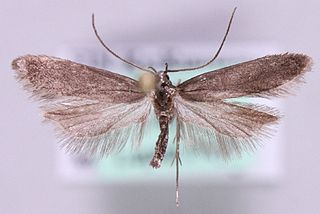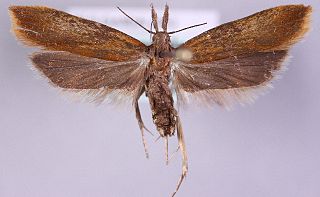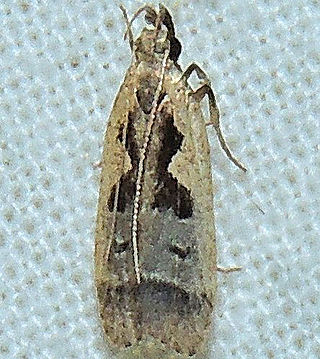
Dichomeris is a genus of moths in the family Gelechiidae erected by Jacob Hübner in 1818.

Acanthophila latipennella is a moth in the family Gelechiidae. It is found in south-eastern Siberia and Europe, where it has been recorded from Norway south to Italy and east to Russia.

Dichomeris rasilella is a moth in the family Gelechiidae. It is found in China, Taiwan, Korea, Japan, Russia and Europe, where it has been recorded from Spain, France, Italy, Estonia, Latvia, Ukraine, Belarus, Poland, Romania, the Czech Republic and Slovakia.

Dichomeris ustalella is a moth in the family Gelechiidae. It is found in south-eastern Siberia, the Caucasus, Transcaucasia, Korea, Japan, China and Europe, where it has been recorded from most of the continent, except for Ireland, the Iberian Peninsula and Scandinavia.
Dichomeris nenia is a moth in the family Gelechiidae. It was described by Ronald W. Hodges in 1986. It is found in North America, where it has been recorded from Texas, Arkansas, Alabama, Mississippi and Florida.
Dichomeris ardelia is a moth in the family Gelechiidae. It was described by Ronald W. Hodges in 1986. It is found in North America, where it has been recorded from Florida.
Dichomeris siren, the least dichomeris moth, is a moth in the family Gelechiidae. It was described by Ronald W. Hodges in 1986. It is found in the United States, where it has been recorded from Maryland, Connecticut, Indiana, Michigan, New Jersey, Virginia, South Carolina, Tennessee and Georgia.
Dichomeris georgiella is a moth in the family Gelechiidae. It was described by Francis Walker in 1866. It is found in North America, where it has been recorded from south-eastern Canada and Maine, south to Florida, west to Texas, Oklahoma and Illinois. It has also been recorded from Colorado and Arizona.
Dichomeris gleba is a moth in the family Gelechiidae. It was described by Ronald W. Hodges in 1986. It is found in North America, where it has been recorded from Illinois, Arkansas, Missouri, Texas, Colorado and New Mexico.

Dichomeris bilobella, the bilobed dichomeris moth, is a moth in the family Gelechiidae. It was described by Philipp Christoph Zeller in 1873. It is found in North America, where it has been recorded from Nova Scotia, southern Quebec and southern Ontario to Maryland, Minnesota, Missouri and eastern Kansas.

Dichomeris aleatrix, the buffy dichomeris moth, is a moth in the family Gelechiidae. It was described by Ronald W. Hodges in 1986. It is found in North America, where it has been recorded from southern Ontario south to Tennessee and north to Illinois.

Dichomeris ochripalpella, the shining dichomeris moth, is a moth in the family Gelechiidae. It was described by Philipp Christoph Zeller in 1873. It is found in North America, where it has been recorded from southern Quebec and southern Ontario to New Jersey, North Carolina and Arkansas.
Dichomeris pelta is a moth in the family Gelechiidae. It was described by Ronald W. Hodges in 1986. It is found in North America, where it has been recorded from South Carolina and Florida.
Dichomeris bolize, or Glaser's dichomeris moth, is a moth in the family Gelechiidae. It was described by Ronald W. Hodges in 1986. It is found in the United States, where it has been recorded from Nebraska, Connecticut, Florida, Maryland, Massachusetts, New Jersey, New York, North Carolina and Texas.
Dichomeris illusio is a moth in the family Gelechiidae. It was described by Ronald W. Hodges in 1986. It is found in North America, where it has been recorded from Alabama, Mississippi and Florida.
Dichomeris isa is a moth in the family Gelechiidae. It was described by Ronald W. Hodges in 1986. It is found in North America, where it has been recorded from Oklahoma, Arkansas, Florida, Georgia, Illinois, Kentucky, Massachusetts, Mississippi, Missouri, New Jersey, New York, North Carolina, Ohio, Pennsylvania, Tennessee, Texas and Ontario.
Dichomeris imitata is a moth in the family Gelechiidae. It was described by Ronald W. Hodges in 1986. It is found in North America, where it has been recorded from Texas and Mississippi.
Dichomeris baxa is a moth in the family Gelechiidae. It was described by Ronald W. Hodges in 1986. It is found in North America, where it has been recorded from California.
Dichomeris sybilla is a moth in the family Gelechiidae. It was described by Ronald W. Hodges in 1986. It is found in North America, where it has been recorded from Arizona.
Dichomeris hortulana is a moth in the family Gelechiidae. It was described by Edward Meyrick in 1918. It is found in India, South Africa, the Seychelles, where it has been recorded from Silhouette and Mahé as well as Mauritius and Mayotte.







